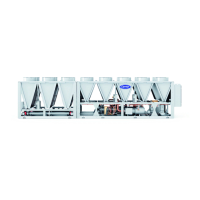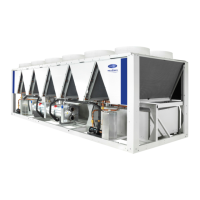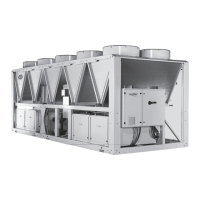56
apply an anti-seize compound to the bolt threads. Make
sure the oval neck of each bolt seats properly in the bolt
hole.
7. Tighten the nuts evenly by alternating sides until metal-
to-metal contact occurs at the bolt pads. Make sure the
housings’ keys engage the grooves completely. It is im-
portant to tighten the nuts evenly to prevent gasket
pinching.
8. Visually inspect the bolt pads at each joint to ensure
metal-to-metal contact is achieved.
COMPRESSOR OIL SYSTEM — Each compressor/circuit
has its own oil system which includes an oil filter, oil solenoid,
check valve, oil level switch, oil separator heater, oil pressure
transducer, and an oil shut-off valve. A typical oil system is
shown in Fig. 51. See Table 36 for required oil quantity per cir-
cuit, initially included from the factory.
Table 36 — Unit Oil Quantities
Oil Charge
— When additional oil or a complete charge is
required it must meet the following specifications:
• Manufacturer . . . . . . . . . . . . . . . . . . Emkarate RL220XL
• Oil Type. . . . . . . . . . . . . . . . Inhibited polyolester-based
synthetic compressor lubricant for use with screw compressors.
• ISO Viscosity Grade . . . . . . . . . . . . . . . . . . . . . . . . . 220
Do not reuse drained oil or any oil that has been exposed to the
atmosphere.
Oil is available in the following quantities from your local
Carrier representative:
If unsure if there is low oil charge in the system, follow the
steps below:
1. If the unit shuts off repeatedly from a low oil level alert, it
may be an indication of inadequate oil charge: however, it
could also indicate the oil is not being reclaimed from the
low-side of the system.
2. Begin running the circuit at full load for 1
1
/
2
hours.
NOTE: An adequate load must be available.
3. After running the unit for 1.5 hours at full load, stop the
unit. Check the oil level in the oil separator sight glass.
An oil level should be visible in the upper sight glass. If
level is not visible, the unit is low on oil charge.
4. Add oil until the oil is at the center of the upper sight
glass. Make sure not to add oil beyond this level as ex-
cess oil will be carried out of the oil separator into the
system and might lead to system instabilities at certain
conditions.
5. The factory oil charging stations are programed to add
precise amount of oil to the oil separator and if the oil lev-
el while inspection shows higher than middle of the top
sight glass then it could be due to refrigerant mixed in it.
Do not remove any oil.
Add oil to the oil separator using the
1
/
4
-in. access fitting
on the side of the separator.
NOTE: To facilitate the oil charging process, ensure that
the unit is not running when adding oil. The system is
under pressure even when the unit is not running, so it is
necessary to use a suitable pump to add oil to the sys-
tem. Using a suitable pump, add
1
/
2
gal (1.9 L) of oil to
the system. Continue adding oil in
1
/
2
gal (1.9 L) incre-
ments until the problem is resolved, up to a maximum of
1.5 gal (5.7 L).
Oil Filter Maintenance
— Each circuit has one oil filter
bolted externally to the compressor. Oil line pressure drop is
monitored by the control. Oil line pressure drop is calculat-
ed by subtracting oil pressure (OPT) from discharge pres-
sure (DPT). If the oil line pressure drop exceeds 30 psig
(206.8 kPa) for 5 minutes the control will generate a High
Oil Filter Pressure Drop alert. The High Oil Filter Pressure
Drop alert will not shut down the compressor, but instead
indicates that the oil filter is dirty. If oil pressure line losses
exceed 50 psig (344.7 kPa) for more than 30 seconds then
the control will shut down the circuit on Maximum Oil Fil-
ter Differential Pressure Failure.
Replacing the Oil Filter
— Close the oil service valves on ei-
ther side of filter by removing the cap and closing the valve.
One is connected to the oil filter and the other is mounted on
the compressor. Connect a charging hose to the ¼-in. access fit-
ting port located between the filter and compressor. Bleed off
the oil located in this section. A quart of oil is typically re-
moved during this process. Unscrew the nuts on either side of
the filter. Remove the filter and install the new one. Make sure
to remove the plastic caps from the new filter before installa-
tion. Take care not to lose or damage the new o-rings on the
new filter. Draw a vacuum at the service port. Remove the
charging hose and open the oil service valves. Replace caps on
access port and service valves. Check both fittings for leaks.
Evaporator Service — The 30XV units use flooded
style evaporators.
ISOLATION VALVE — The isolation valve is a factory-
installed option for 30XV units. The option includes a
butterfly-style suction service valve on the suction lines,
and manual ball valves on discharge, evaporator inlet and
economizer lines. The butterfly valve is connected to the
suction line by Victaulic connections. See Fig. 52 and 53
for details on the butterfly suction service valve opera-
tion. The valve locks into place when fully opened or ful-
ly closed.
30XV UNIT SIZE
OIL CHARGE (gal, [liters])
Circuit A Circuit B
140 - 200 4.0 [17.0] 4.0 [17.0]
225 6.0 [20.8] 4.0 [17.0]
250 - 325 6.0 [20.8] 6.0 [20.8]
QUANTITY TOTALINE PART NO.
1 Quart P903-2325
1 Gallon P903-2301
5 Gallon P903-2305
CAUTION
Compressor oil is pressurized. Use proper safety precau-
tions when relieving pressure.

